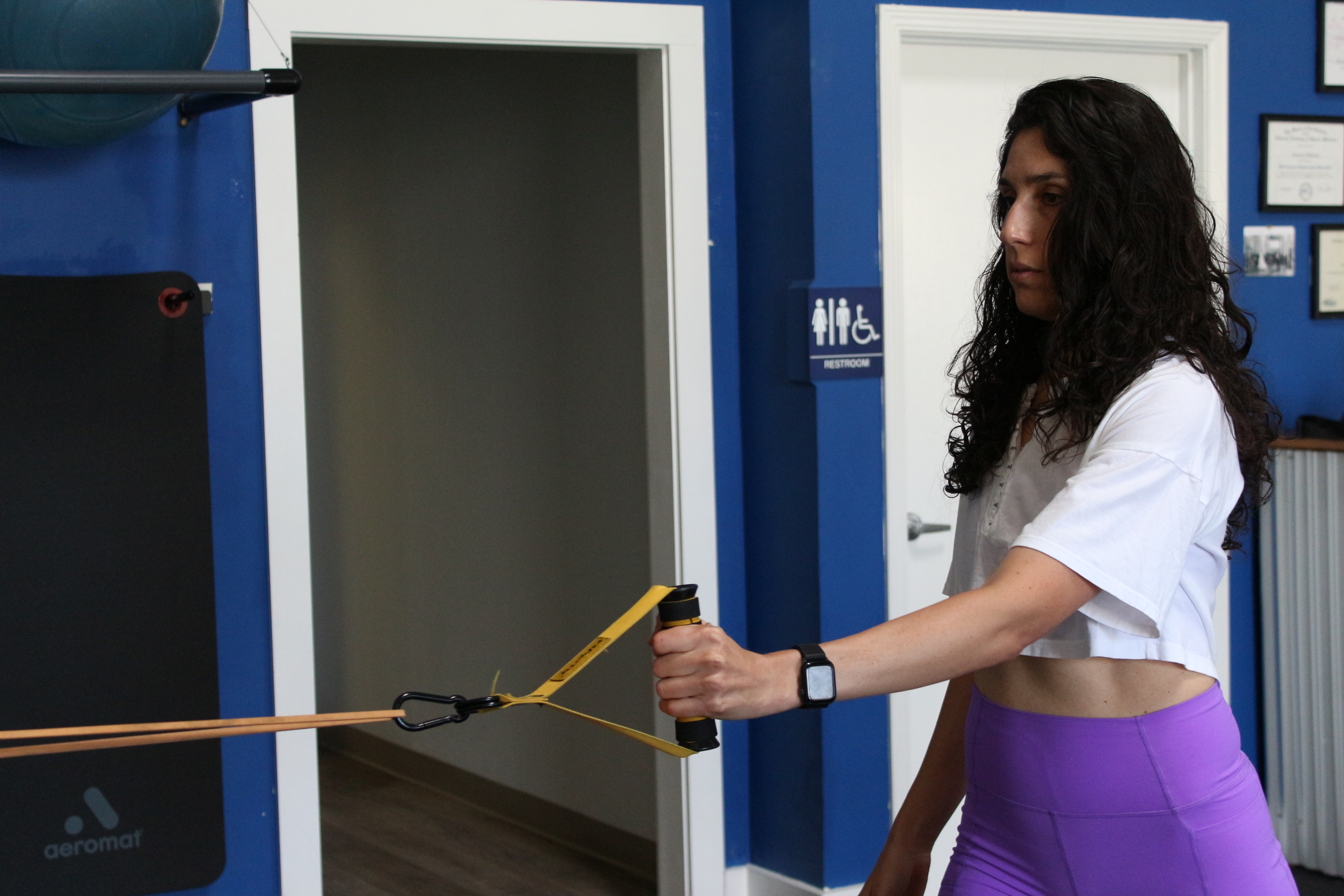Upper extremity movements are present in a multitude of events in our everyday lives. Reaching overhead to obtain a coffee mug from a high shelf in the cupboard, rotating and reaching backward to grab hold of a seatbelt and fastening it before disembarking in our cars, or simply putting on a jacket are a few examples of what our shoulder joints allow us to perform in a normal day. However, when neck, shoulder, or scapular pain arises, a task as simple as putting on a hat or blow-drying one’s hair can be an undesirable experience of pain and discomfort.
The shoulder joint is a ball and socket joint. Other joint types present within the body include hinge, saddle, or facet joints. Along with its ball and socket sibling, the hip joint, the shoulder joint allows for impressive circular and rotational ranges of motion. Equipped with the ability to project the arm forward, out to the side, overhead, and maneuver behind the body, the shoulder joint allows our arms to move through various planes of movement so our hands can grab objects to lift, pull, and push them to our desired location. Additionally, the impressive range of motion of the shoulder grants humans the ability to perform athletic activities such as throwing and catching balls or striking objects with instruments such as golf clubs, tennis rackets, or pickleball paddles.
The free space within the bony framework of the shoulder allows for an increased range of motion for the upper extremities. Unlike the dense bony fortress that the pelvic girdle offers the hip’s ball and socket joint, the shoulder joint has significantly less stability than the hip joint. The clavicle, shoulder blade, rib cage, and humerus are attached by muscles, tendons, and ligaments that don’t offer strong bone-to-bone attachments like the hip. This is why the shoulder has an increased ability to perform circular movements compared to the hip.
The scapula, or shoulder blade, has a large array of muscular attachments to the posterior aspect of the ribs, spine, and humerus. These muscular attachments of the scapula to the humerus allow for the sophisticated movements of the upper extremities, each responsible for an impressive array of rotation, flexion, extension, adduction, and abduction. Due to the lack of bone-to-bone attachments and the increased demand for the muscular attachments present in the shoulder, the increased potential for injury in the form of overuse and underuse of the shoulder stabilizer muscles is at a higher risk than that of the hip joint. Therefore, the increased awareness to support the shoulder’s health for our everyday life functionality can’t be overstated.
Similar to the decreased size of the humerus, clavicle, scapula, and rib bones within the shoulder joint when compared to the femur and pelvic girdle of the hips, the muscles responsible for producing force and reinforcing the structural integrity within the shoulder are smaller than the hips muscles. For example, the gluteus maximus is roughly twice the size of the pectorals. The shoulder muscles of the rotator cuff and scapular stabilization have a limit to the amount of power and structural stability they can maintain for upper extremity force-producing movements. If the shoulder muscles become overworked, the risk for shoulder musculoskeletal afflictions can occur in the form of rotator cuff syndrome, frozen shoulder, or torn tendons and ligaments. To prevent this, focusing on consistently practicing shoulder injury prevention movements is critically important to staving off debilitating shoulder joint injuries.
Some of us incorporate vitamins and immune system support supplements within our diets. A few examples include taking B vitamins in the morning, some aged garlic extract at night, collagen powder in our smoothies, or increased turmeric in our diet. These supplements are aimed at avoiding getting sick, decreasing inflammation, and influencing the reduced likelihood of advanced forms of arthritis. If there were a magic vitamin we could take to reduce our shoulder rotator cuffs from developing pain, I wouldn’t be writing this article. Consistent adherence to injury prevention, rehabilitative, and strengthening exercises for the shoulder joint is the “magic pill” that strongly influences the avoidance of developing chronic shoulder pain and injuries.
As a form of consistent practice to ensure our clients know a few best practices to decrease the likelihood of shoulder injury during our personal training sessions, we require all exercise participants to conduct a series of mobility tactics meant to activate the stabilizing muscles of the shoulder joint. The same movements are performed before every training session in meticulous detail under our professional critiques. An example of one shoulder movement prep includes scapular protraction and retraction:
Scapular Protraction and Retraction: Lift your arms to about armpit level and bend them at a 90-degree angle. While maintaining your elbows at a 90-degree angle and keeping your fingertips facing forward, glide your shoulder blades forward along your rib cage until you feel a stretch in the upper back and muscular sensation in your pectoral region. Reverse the motion and glide your shoulder blades backward against your ribs. You should feel muscular sensation in the muscles surrounding your shoulder blades. Repeat this movement for five to ten repetitions.
The purpose of overviewing and rehearsing these regularly practiced techniques is not only to reinforce the structural integrity of the shoulder joint, but also so exercise participants never forget these techniques. That way, they can take their “injury prevention vitamins” via consistent exercise every time they workout at our fitness center, or more importantly, under their own exercise settings during a home workout or at a local gym. By consistently practicing injury prevention and mobility movements for the shoulder joint, we have the potential to have functional upper extremities to help us live happy, healthy, and strong lives.
Sean McCawley, the founder and owner of Napa Tenacious Fitness in Napa, CA, welcomes questions and comments. Reach him at 707-287-2727, napatenacious@gmail.com, or visit the website napatenaciousfitness.com.

